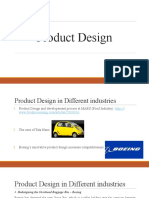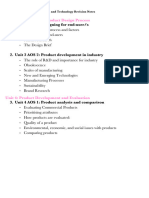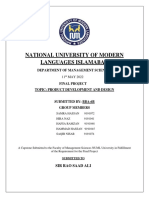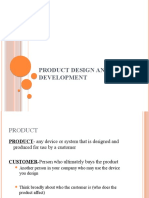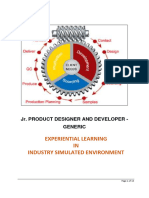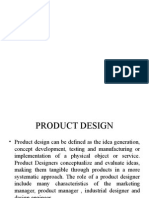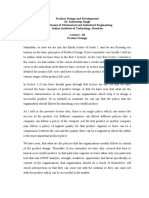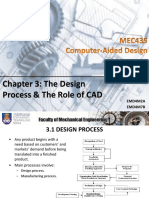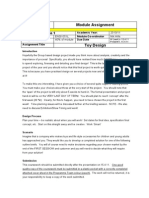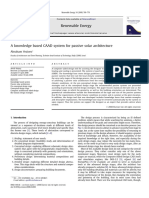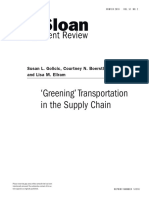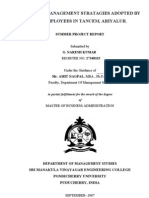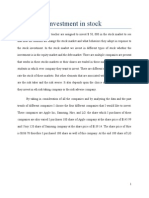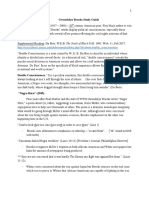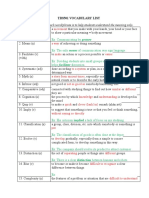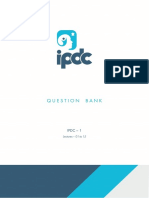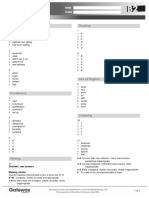MSE7004 Product Innovation and New Technologies
Assignment brief (001/002) - (30/70%)
Tutors: Dr Mo Sanami
Hand-in Date: 001 Presentation (LO 1, 2) 04th Dec 2022
002 Written Report (LO 3,4,5) 06th Jan 2023
Learning Outcomes
1 Demonstrate systematic knowledge and understanding of design processes and
methodologies. (D2fl, D10m) (K3)
2 Effectively contribute to teamwork and compare the different roles within an
engineering team. (EP4fl, P11m) (P7)
3 Critically appraise the requirement for engineering activities to promote
sustainable and innovative development. (D3fl, D11M) (P4)
4 Critically appraise the commercial, economic and social context of engineering
processes. (ET2fl, EL9M) (K5)
5 Demonstrate the ability to apply and adapt design processes and methodologies in
unfamiliar situations. (D2fl, D10M) (P3)
Title: Appliance Innovative Design and Development
Scenario
You are part of a design team working for the Company of Design Technologies. You need to
design and develop a new product/device for global distribution, although the main market
is in the UK. They pride themselves on providing easy to use, reliable and functional products.
In order to stay ahead, they regularly revisit designs to see if they can be redeveloped,
reshaped, or rebranded. Function is always the main priority; however, sales of a product may
be influenced by other factors such as the look.
Within your team, you will be expected to choose a product of your choice with Mechanical
and Electrical elements to review with the intention of redevelopment. In order to inform this
redevelopment, your team will undertake research to understand the various systems and
interactions with users.
Your team may propose a product, that it must fall within the following constraints:
• Be multi part
• Be Portable or stand mounted
• Have a mechanical element i.e. pump, compressor
• Must have human interaction
• Must be within the Engineering Device Development definition of an engineering
device
Page 1 of 7
�Do not consider electrical/computer components such as circuit boards or the writing of
software etc. although writing a software can be part of your project (i.e. using Arduino,
MATLAB to control/simulate your product however, physical parts like this can be
approximated and represented using an ‘envelope’. The scope of design will be further
discussed with module tutors.
Guideline Scheme of work (can be adapted).
Identify potential areas of investigation (mapping) and process (Kutz, Myer. Vol II pg:4 2009)
Undertake and record research to justify the stages (throughout)
Create an initial product specification; (Kutz, Myer. Vol II pg:9 2009) (Mandenius, et
al pg:16 onwards 2011)
a) Initial Market feasibility study.
Having identified the product, you wish to develop. Address these questions:
1) Identify the primary customer for your product. Is the market segmented into
different groupings? What are their expectations regarding:
• Price point
• Technical innovation – how informed are they
• Reliability / service life
• Performance compared to competition
• What are the critical features of the product?
• Are there features missing or in need of radial enhancement?
• Can you suggest features which will surprise the customer (wow factor)
2) Are there secondary customers, or groups who have an influence on purchasing
behaviour?
3) What are the competitor products? Do they use similar or complementary
technology to your concept? What is their price point? What are their product’s
strengths and weaknesses? How will your product make an impact…. Cheaper,
better performance, easier fonctionality, appearance, etc.
b) To Do List
1) Identify and prioritise your customer groups. Potential production numbers /
markets / competition
2) Brainstorm their needs in respect of your product
3) Factors influencing shape / colour / materials
4) Create a series of concept sketches
5) Explain the function of product and Approximate dimensions
6) Compose the questionnaire to examine these needs – what are the important
features or functions? Use 1-10 rating scale
7) Leave scope for gathering information about needs which you have not
foreseen – open questions etc…
Page 2 of 7
� 8) Examine the customer’s perception of the competition’s products … open
ended comments or specific points (can research features in advance)
9) Use a design methodology to select a concept for further development
10) What is the purpose of IP in the product development process? and/or, Is there
any patentable feature or design in the product you have proposed? If yes,
what would be your approach?
This will give you an initial picture of the likely market for your product and allow
you to sharpen your marketing focus on critical features of the conceptual design.
Move to Detail Design stage (Kutz, Myer. Vol II pg:14 2009)
Create CAD development models
Create system diagrams / maps to explain functionality
Create maps to show how users as outlined by Chan (pg:18, 2016) interact with the
product
Create detailed sketches of operator control panel
Use anthropological data to establish appropriate dimensions
Explain Assembly of the components
Finalise the outer design casings of the product and make changes if needed.
Suggest materials and justify the reasons of choice (use CES Edupack)
Consider manufacturing methods in your design (use CES Edupack)
Explain how sustainability has been incorporated into your solution – end of life
Final Stage
Write up report
Produce Rendered CAD images / Artefacts / Engineering drawing
Assessment 001
Give a Presentation to sell your product to the client (20 minutes + 10 minutes
question)
Submission requirements
A single group report should be uploaded to Turnitin via Moodle (Maximum 8000
words, estimated 2000 words for each student)
All other files (CAD, Renders, Excel) Uploaded via Moodle Upload
A single Presentation should be uploaded to Turnitin via Moodle
Notes on Team Structure and Management
Your team will work in a flat management style and be jointly responsible for work on the
project. Your team is advised to elect a coordinator, but this is not strictly necessary. The
Page 3 of 7
�module tutor will act as the Supervisor for each group dealing with absence, lack of
contribution, sickness, disputes, and other hierarchical management aspects.
Whilst this is a group project you will receive an individual grade based on evidence of your
participation and contribution. The evidence is the weekly register, weekly logbook entries,
work attributed to you in the online resource, peer review. The module tutor will advise you
of the online resource for weekly meetings.
Bibliography
Human-Machine Interface
Chan, AY 2016, BIOMEDICAL DEVICE TECHNOLOGY, Charles C Thomas,. Available from:
ProQuest Ebook Central. [21 December 2016].
Product Design Process
Kutz, Myer. 2009., Biomedical Engineering & Design Handbook, Volume II. [online]. McGraw-
Hill Publishing. Available from:<http://www.myilibrary.com?ID=241562> 16 January 2017
Mandenius, Carl-Fredrik;Björkman, Mats. 2011., Biomechatronic Design in Biotechnology.
[online]. Wiley. Available from:<http://www.myilibrary.com?ID=317598> 17 January 2017
Expected number of resources:
You will be expected to at least to include 15-20 references relative to the overall project.
Page 4 of 7
�Report Layout and marking scheme 70%
Initial Specification 40
Front Sheet
Abstract text
TOC
1. Introduction text
2. Brainstorming Images and text 5
3. Competitors images/table and text 5
4. User interaction text 5
5. Further initial research – Graphs/ Images/ text Edupack / 25
could include but is not internet sources / written comments
confined to:
Product deconstruction
Third party investigations
Identifying customer needs
Product Design Specification 25
6. Sketches and ideas Images and discussion IND 10
7. Design selection – process Drawing, (matrix) 5
Concept generation
8. Product function, Materials Graphs/ Images/ text Edupack / 10
research, Manufacturing, internet sources / written comments
Regulations, Reliability,
Durability, Packaging, Time
and cost
Development Process 35
9. Manager reports TM – Assembly Drawings / CAD detailed IND 30
product design, engineering drawing
TM, Technical Manager QFD
PM, Product Manager PM - Manufacturing and sustainability,
MM, Marketing Manager Identify suppliers, FMEA table
SM, Sale Manager MM – Market feasibility, Identify
competitors, Marketing, advertising
materials, marketing questioner, Kano
model
SM – product development economics,
costs, selling price, fixed and variable
cost, cash fellow chart, sale income,
OSD
Conclusions In this section you will summarise the 5
project, speak about the knowledge you
acquired at each stage and how you
implemented this into the next. Say
how well the outcome satisfies the brief
Page 5 of 7
� and elements which you could have
been included to improve it.
May also include recommendations
Total 100
Appendix (Teams) A Self-reflective appraisal
Comments around group working ± 10
SWOT analysis on your team
Appendix B Sketches / Bigger images / ortho
drawings/ Marketing renders etc.
The scheme allows for 40% of the total marks to be an individual grading element:
Identify which Sketch is done by who
Identify Managers e.g. Production Manager – XXXXXX
Green Elements – marked as group contribution and overall submission.
Orange Elements – marked on individual merit.
Blue Elements – These also influence the overall individual grade and include measurables
such as:
Attendance - registers
Peer review – Where you mark each other including yourself
Engagement – evidenced by Trello or equivalent
Refer / Defer work Scheme
As the marking system permits individual grading, there is always the chance that individuals
in a group may not produce work that is of an adequate standard. There is also the chance
that students may have had mitigating circumstances and need to complete the module out
of sequence. It is very difficult to arrange a repeat group assessment after the module has ran
so referred students will use the existing report produced by their group and complete the
individually marked components as this represents 40% of the marks allocated.
A student who is referred / deferred will need to produce:
i. 1 overall summary of the group report (1000 words max)
ii. 2 annotated A4 sketches
iii. 1 Manager report for the role they were assigned in the group
iv. 1 CAD part which can be an addition to the design or alternatively one of the
another task of QFD, FMEA, Kano model, OSD wich is not included in your
manager role. (i.e. if you are a technical manager in addition to QFD you need
to include one of FMEA, Kano model or OSD in your sub report)
Page 6 of 7
�If any of the elements above were already completed this will be taken into consideration
and if worthy of 50% the student will not be asked to do these again. All elements of referral
work need to be of sufficient quality to attain at least 50% to pass. Defer marks will not be
capped.
The abovementioned work will be packaged into a single pdf and uploaded to the refer link
tab in the Turnitin for this module in Moodle. The new work added should be highlighted so
it can be identified. Deadline will be confirmed via email.
Page 7 of 7




